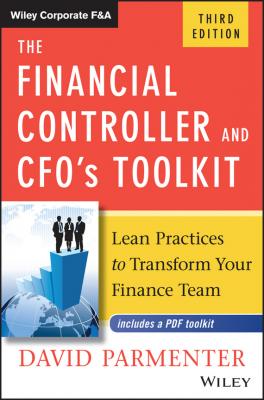The Financial Controller and CFO's Toolkit. Parmenter David
Читать онлайн.| Название | The Financial Controller and CFO's Toolkit |
|---|---|
| Автор произведения | Parmenter David |
| Жанр | Зарубежная образовательная литература |
| Серия | |
| Издательство | Зарубежная образовательная литература |
| Год выпуска | 0 |
| isbn | 9781119291329 |
One smart accountant I have come across worked out that budget holders know little more about month-end purchase invoices at day+2 than at day 2. So, the accountant introduced accrual cutoff on day 2, the day before month-end. Budget holders were required to send their last invoices for processing to meet the month-end AP cutoff by noon day–2, which gave AP 24 hours to process them before the day 1 AP cutoff. He also told them to prepare their accruals in the afternoon of day–2, directly into the G/L.
All that is required is a guarantee that all invoices approved for payment by budget holders within the deadline will in fact be processed prior to the AP cutoff, or accrued directly by the AP team.
Cutting off accruals early recognizes that month-end invoices will not arrive miraculously by day+1 or day+2 so staff will need to phone some key suppliers to get accrual information regardless of when the cutoff is.
Set a Materiality Rule for Accruals
We need to set a materiality rule for accruals. If materiality is set at $40,000 for a P/L item, I would recommend setting the threshold for the minimum department accrual at around 40–50 % of this number. In this case it would be between $16,000 and $20,000, so I would go for $20,000. If a department is too small to have $20,000 worth of accruals, then it does not need to do accruals.
If materiality is set at $20,000 for a P/L item, then we might set the minimum threshold for accrual total for each business unit between say $8,000–$10,000 (using the 40–50 % rule). In this case I would set it at $10,000. If a department is too small to have $10,000 worth of accruals, then it does not need to do accruals. This should limit accruals to less than half the budget holders in the organization. If a manager of a small budget complains, point out that they will be able to accrue when they get promoted. We should set limits on the individual debit items in the accruals to somewhere around a quarter of the accrual threshold. If departmental accruals must be greater than $20,000, each debit must be greater than $5,000.
Avoid Inter company Adjustments
To stop the politics of intercompany disagreements at month-end instigate a simple rule that the accounts payable (AP) or accounts receivable (AR) ledger is always right, and the other party has to adjust accordingly. Leave the intercompany parties to sort the issues out in the following month. I have included a draft memo in Appendix A that the CEO would be advised to send out.
Конец ознакомительного фрагмента.
Текст предоставлен ООО «ЛитРес».
Прочитайте эту книгу целиком, купив полную легальную версию на ЛитРес.
Безопасно оплатить книгу можно банковской картой Visa, MasterCard, Maestro, со счета мобильного телефона, с платежного терминала, в салоне МТС или Связной, через PayPal, WebMoney, Яндекс.Деньги, QIWI Кошелек, бонусными картами или другим удобным Вам способом.
